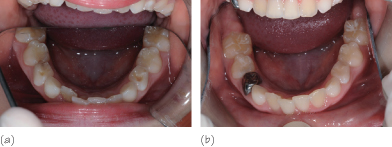20
Plastic Restorations in Primary Molars
Introduction
Wedging a dollop of glass ionomer cement between cavity walls after inadequate removal of caries without local analgesia is not good-quality restorative dentistry and it is no surprise that such restorations frequently fail. All efforts should be made to provide good-quality restorative care for carious primary teeth, with restorations that are performed to standards that do not circumvent the basic principles of restorative dentistry. Two important principles are removal of all caries, which is only possible after achieving good pain control with administration of local analgesia, and the prevention of secondary caries (Fig. 20.1). For restorations to be successful and to last for the lifetime of the primary molars the following need to be considered:
- What is the size and site of the lesion?
- Is the pulp healthy or is it likely to be inflamed?
- Are the properties of the material being considered for use compatible with the planned restoration?
Figure 20.1 Bitewing radiographs showing composite restorations that have failed because of inadequate removal of caries and also poor preventive control following restorations.

Size and Site of Lesion
Plastic restorations have the best outcome for small lesions affecting one or two surfaces. Full coverage, such as with stainless steel crowns, should be provided for more extensive and multi-surface caries. In the author’s opinion plastic restorative materials perform the best for:
- occlusal cavities;
- small proximal caries that involve less than a third of the marginal ridge (Fig. 20.2);
- proximal caries that is not clinically evident but diagnosed on bitewings (Fig. 20.3).
Figure 20.2 Mesial caries in 85 (a) which was considered suitable for restoration with composite restoration (b).

Figure 20.3 Bitewing radiographs showing distal caries in 64 (a) which was/>
Stay updated, free dental videos. Join our Telegram channel

VIDEdental - Online dental courses


